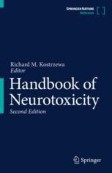Search
Search Results
-
The Absence of Gastrointestinal Redox Dyshomeostasis in the Brain-First Rat Model of Parkinson’s Disease Induced by Bilateral Intrastriatal 6-Hydroxydopamine
The gut-brain axis plays an important role in Parkinson’s disease (PD) by acting as a route for vagal propagation of aggregated α-synuclein in the...

-
Byrsonima sericea Ethanol Extract Protected PC12 Cells from the Oxidative Stress and Apoptosis Induced by 6-Hydroxydopamine
Parkinson’s disease is characterized by the progressive loss of dopaminergic neurons in the nigrostriatal pathway and oxidative stress is one of the...

-
Characterization of graded 6-Hydroxydopamine unilateral lesion in medial forebrain bundle of mice
Parkinson’s disease (PD) is the second most common age-related neurodegenerative disease, with a progressive loss of dopaminergic cells and fibers....

-
Protective effects of verbenalin and (+)-eudesmin against 6-hydroxydopamine-induced oxidative/nitrosative stress in SH-SY5Y cells
BackgroundThe purpose of this research was to study whether verbenalin, an iridoid glucoside, and (+)-eudesmin, a furofuran lignan isolated from...

-
Prosaposin PS18 reduces dopaminergic neurodegeneration in a 6-hydroxydopamine rat model of Parkinson’s disease
Saposin and its precursor prosaposin are endogenous proteins with neurotrophic and anti-apoptotic properties. Prosaposin or its...

-
Examination of diverse iron-chelating agents for the protection of differentiated PC12 cells against oxidative injury induced by 6-hydroxydopamine and dopamine
Labile redox-active iron ions have been implicated in various neurodegenerative disorders, including the Parkinson's disease (PD). Iron chelation has...

-
Autophagy and neuroprotection in astrocytes exposed to 6-hydroxydopamine is negatively regulated by NQO2: relevance to Parkinson’s disease
Dopaminergic degeneration is a central feature of Parkinson’s disease (PD), but glial dysfunction may accelerate or trigger neuronal death. In fact,...

-
Neonatal 6-hydroxydopamine lesioning of rats and dopaminergic neurotoxicity: proposed animal model of Parkinson’s disease
The neurotoxin 6-hydroxydopamine (6-OHDA), following pretreatment with the norepinephrine transport inhibitor desipramine, selectively destroys...
-
6-Hydroxydopamine Lesioning of Dopamine Neurons in Neonatal and Adult Rats Induces Age-Dependent Consequences
Over 45 years ago, it was discovered that the compound 6-hydroxydopamine (6-OHDA) destroys catecholamine (CA)-containing neurons when injected...
-
Alpha-Mangostin Alleviates the Short-term 6-Hydroxydopamine-Induced Neurotoxicity and Oxidative Damage in Rat Cortical Slices and in Caenorhabditis elegans
The development, at the experimental level, of therapeutic strategies based on natural products to attenuate neurological alterations in degenerative...

-
Metabolomics and biochemical alterations caused by pleiotrophin in the 6-hydroxydopamine mouse model of Parkinson’s disease
Pleiotrophin (PTN) is a cytokine involved in nerve tissue repair processes, neuroinflammation and neuronal survival. PTN expression levels are...

-
6-Hydroxydopamine Induces Neurodegeneration in Terminally Differentiated SH-SY5Y Neuroblastoma Cells via Enrichment of the Nucleosomal Degradation Pathway: a Global Proteomics Approach
The SH-SY5Y human neuroblastoma cells have been used for decades as a cell-based model of dopaminergic neurons to explore the underlying science of...

-
Chronic H3R activation reduces L-Dopa-induced dyskinesia, normalizes cortical GABA and glutamate levels, and increases striatal dopamine D1R mRNA expression in 6-hydroxydopamine-lesioned male rats
RationaleDyskinesias induced by L-3,4-dihydroxyphenylalanine, L-Dopa (LIDs), are the major complication in the pharmacological treatment of...

-
Thymol protects against 6-hydroxydopamine-induced neurotoxicity in in vivo and in vitro model of Parkinson’s disease via inhibiting oxidative stress
BackgroundParkinson’s disease (PD) is a multifactorial movement disorder with the progressive degeneration of the nigrostriatal system that impairs...

-
Parkinson Disease-Modification Encompassing Rotenone and 6-Hydroxydopamine Neurotoxicity by the Microtubule-Protecting Drug Candidate SKIP
Encompassing live cell imaging and morphometrics at the microscopical level, we showed here, for the first time, protection of neuronal-like cells by...

-
Curcuma longa extract ameliorates motor and cognitive deficits of 6-hydroxydopamine-infused Parkinson’s disease model rats
Parkinson’s disease (PD) results mostly from the degeneration of dopaminergic neurons in the substantia nigra pars compacta. It is characterized by...

-
Reduced acetylcholine and elevated muscarinic receptor 2 in duodenal mucosa contribute to the impairment of mucus secretion in 6-hydroxydopamine-induced Parkinson’s disease rats
Patients with Parkinson’s disease (PD) have a higher incidence rate of duodenal ulcers. The mucus barrier provides the first line of defense for...

-
Exercise-Induced Neuroprotection in the 6-Hydroxydopamine Parkinson’s Disease Model
Exercise exerts helpful effects in Parkinson’s disease. In this study, the 6-hydroxydopamine (6-OHDA) injection was used to investigate the effect of...

-
Lactiplantibacillus plantarum PS128 Alleviates Exaggerated Cortical Beta Oscillations and Motor Deficits in the 6-Hydroxydopamine Rat Model of Parkinson’s Disease
Parkinson’s disease (PD) is a neurodegenerative disorder characterized by midbrain dopaminergic neuronal loss and subsequent physical impairments....

-
Neuroprotective effect of bromelain in 6-hydroxydopamine induced in vitro model of Parkinson’s disease
BackgroundThis study was designed to investigate the neuroprotective effects of bromelain, which is known to have anti-oxidant and anti-inflammatory...

